USS HARRY E. HUBBARD (DD-748)
World War II
USS HARRY E. HUBBARD (DD-748)
World War II
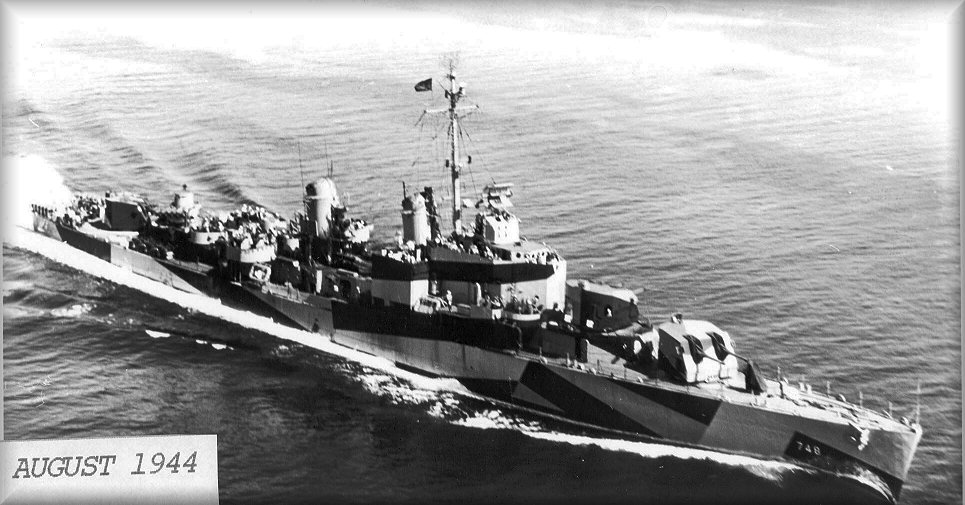
Thanks to Dean Doose for this photo.
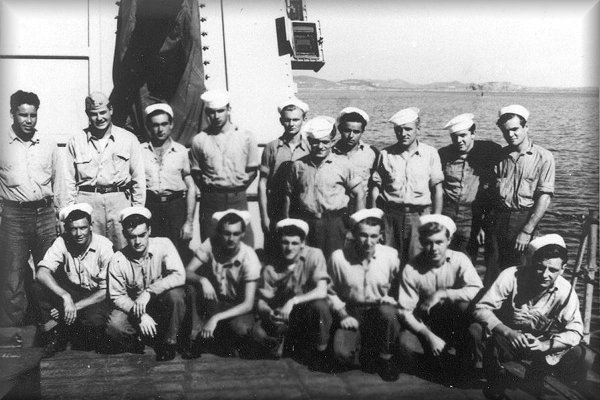
Thanks to Dean Doose for this photo.
First Division at Jinsen, Korea, 1945
Front row, left to right - Everett Sutherlin, Marvin Hauber, Charles Skiba, Daniel Giammarco, Dennis Brooks, Charles Schittler, Robert Smith.
Top Row, let to right -Willis Mcall, Gilbert King, Edmund Shiller, Dean Doose, Joseph Skiba, Dominick Ruszkowski, Rudolph Arellano, Ernest Krieger, Michael Kuzmin, Michael Sweeney.
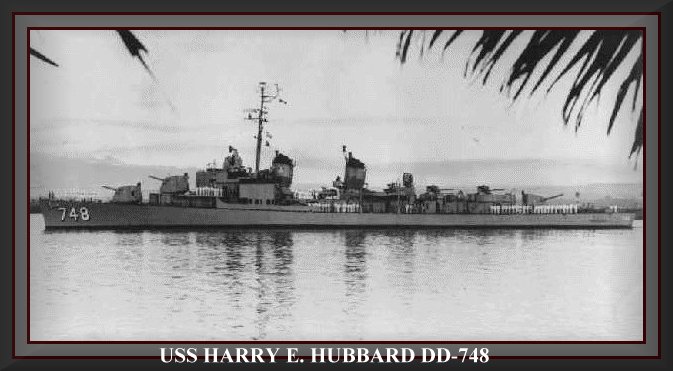
![]()
" . . . Destroyer men have always been proud people. They have been the elite.
They have to be proud people and they have to be specially selected, for destroyer
life is a rugged one. It takes physical stamina to stand up under the rigors of a
tossing DD. It takes even more spiritual stamina to keep going with enthusiasm
when you are tired and feel that you and your ship are being used as a workhorse.
It is true that many people take destroyers for granted and that is all the more
reason why destroyer men can be proud of their accomplishments."
Admiral Arleigh A. Burke

Hubbard, World War II
Photo thanks to Richard H. Wright
Harry E. Hubbard DD-748 was launched 24 March 1944 by the Bethlehem Steel Company, sponsored by Miss Jean Hubbard, daughter and commissioned July 22 1944 with Commander Leonard W. Bailey in command. Flagship of Destroyer Squadron 64, Hubbard trained pre commissioning crews destined for newly constructed warships until sailing for Hawaii 16 January 1945. She served as training ship out of Pearl Harbor until 17 April, then departed for combat. Hubbard arrived at Okinawa on May 8, 1945 having escorted Convoy UOK 8 from Ulithi and reported at once to Destroyer Flotilla Five for duty in the offensive screen as a picket destroyer guarding against the day and night waves of Japanese aerial raids and kamikaze planes. In the next 45 days of operations (until June 21 when the island was secured) the ship spent nineteen days on radar picket station and fifteen days in the antisubmarine and anti-aircraft screens. While so occupied the Hubbard engaged in numerous actions against attacking aircraft. In every instance the planes were either destroyed or driven off. In that period the ship was credited with the destruction of four enemy planes and a "assist" in the destruction of a fifth. The Hubbard in addition assisted in the salvage operation on May 11 of USS HUGH W HADDLEY (DD-774) and EVANS (DD-552) when these two destroyers were badly damaged on radar picket station in their historic battle against fifty enemy planes. HUBBARD, the first destroyer to arrive at the scene, went alongside the Evans and for an hour and a half, until the salvage tugs arrived, rendered fire fighting damage control and medical assistance. During the great raid of May 24-25, the HUBBARD participated in salvage operations of USS BARRY (APD-29) and was left alone to escort the BARRY into Kerama Retto. On the morning of May 25, the HUBBARD shot down two attacking Jap torpedo planes. The HUBBARD suffered no damage during this campaign. The margin of safety was reduced to a minimum as the second of two attacking Kamikazes was shot down only fifty yards from the ship. The pilot pulled up into a stall in an effort to drop on the rear quarter. 40mm's tore him apart. For HUBBARD'S meritorious conduct and service during this period, the commanding officer was awarded the Bronze Star Medal.
Hubbard remained off Okinawa until 24 July 1945, then escorted occupation troops to Jinsen, Korea and carried the Commander of Destroyer Squadron 64 to Chinkai, Korea to oversee the demilitarization of the former Japanese naval base there. She performed escort, mail and communications service for the North China Occupation Force until departing for California 16 March 1946. She arrived in San Francisco 28 March 1946 and decommissioned at San Diego 15 January 1947.
From the diary of Jack W. Groves TN-WT1C as provided by Robert Lundberg, EM2, 1944-1945.
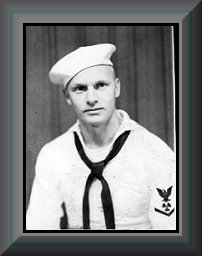
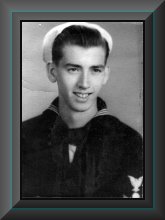
Jack Groves, Hawaii, 1945 (left) Robert Lundberg, EM/3C, age 17. (1944) Youngest petty officer to serve on Hubbard?
Jack and I were members of the original crew. We served together in 1944 and 1945. I left the Hubbard at sea prior to Okinawa. I became very ill and was transferred to The USS Shangri-La (CV-38) for emergency surgery. I had a appendicitis that ruptured during surgery. I was lucky that we were escorting a carrier with superior medical facilities. Jack remembers the day well as when I went across, the two ships came together and I was dunked in the sea a couple of times. I was very ill and never got back to the Hubbard but joined the USS John Q. Roberts (APD 94)
Bob Lundberg
Bob Lundberg died August 31, 2000 

AN OKINAWA INCIDENT
As told to Tom Farland, Cedar Rapids, Iowa by his fatherHarold "Wayne" Farland, was on one of Hubbard's quad-40's at Okinawa. He's been gone now for about nine years, but the stories he told to me and my older brother are just as vivid in my mind today as when he told them to us back in the 50's and 60's. I can't vouch for their accuracy but I remember them virtually word for word.

Harold "Wayne" Farland (left) and two Hubbard Fire Controlmen, identies unknown
1946, Monaco Theatre Restaurant, San FranciscoOn your web site's WWII history, I read "The pilot pulled up into a stall in an effort to drop on the rear quarter. 40mm's tore him apart" and I could hear Dad very clearly:
"...of course, the times we were most vulnerable was right after we knocked down a Jap plane. It was like a big celebration, everybody cheering and jumping up and down, you know. One time we had just finished knocking down a kamikaze, can't remember what it was, but he was coming at us nearly broadside. And he's coming, and he's coming, and we're all shooting at him and finally somebody got him, and we all start yelling like crazy. There was this young kid, too young to be in the Navy, on the 20 right behind my 40, and all at once he's really screaming! I look over there and he's pointing astern and here's a god dam Jap, right down on the water, flying right up our wake! Nobody saw him coming in. We were too busy celebrating. We didn't even know he was there. He could have flown right on into the fantail but he pulled up to dive on us. 'Course it seems like it takes a long time for the 40's to swing round to bear and I thought we'd had it. When we opened up on him I don't think we could have missed him with a fly swatter. I was hitting him, the 20's were hitting him, Francis in the other 40 was hitting him, we were all hitting him. And he just hung right there. It seemed like the longest time but it was probably only a second or so, yet when I close my eyes I can see it, just like he was stuck there. You could see him getting hit, again and again - it almost was like he was being held up there by all the fire. Then he finally nosed over. But the Captain, he threw her into hard turn right then and he missed us, but buddy, it was close. A piece of him took off part of the life-line and when he blew-up astern he sprung one of our prop shafts..."

WORLD WAR II HISTORY OF
U.S.S. HARRY E. HUBBARD (DD 748)
Contributed by Alan C. Carter, Sr.
Prepared for the Hubbard web site by Edward F. Cole, Jr.
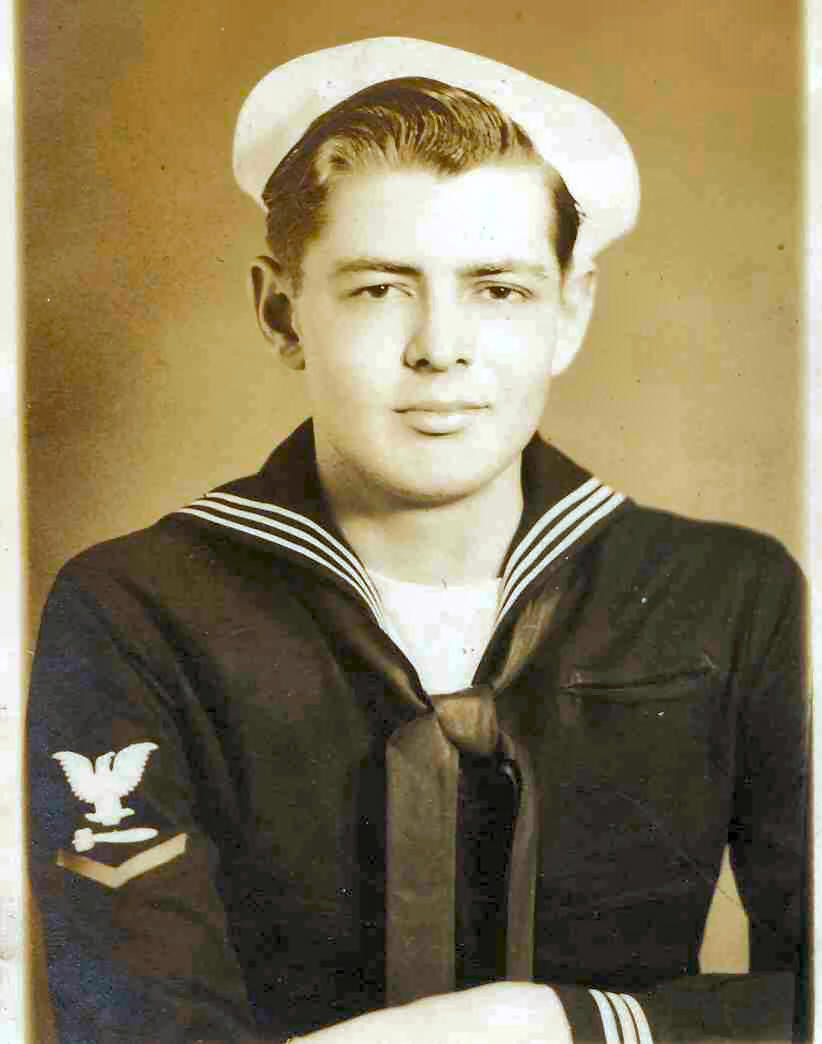
Elvie C Carter TM2
Enclosed you will find a copy of the “History of U.S.S. Hubbard, DD748. Over the years in talking to my father about the exploits of the Hubbard. I find his stories and the History letter to hold true.One episode told to me, but is not mentioned is when the Hubbard was on a shakedown cruise off the East Coast. Sonar picked up a sub. The sub fired two torpedoes at the Hubbard. The captain turned the bow of the Hubbard. One passed to port, the other to starboard. With all hands at battle stations, the Hubbard made depth charge runs on the sonar contact. An oil slick floated to the surface but no debris. Unfortunately, the Hubbard was not credited for the sinking of an enemy submarine. Dad had told of this account several times over the years and never wavered from his story.
I truly hope you can use this on your Hubbard website. It testifies to the Valor and Heroism of the Officers and crew of the Harry E. Hubbard.
Yours truly
Alan C. Carter Sr.
San Antonio, Tx. 78249My father was
Elvie C Carter
TM2
Served from 1944 to 1946
Born 7-31-1925
Died 1-19-2000Named in honor of Commander Harry E. Hubbard, USN who was killed in the Solomon Islands Campaign while commanding U.S.S. MEREDITH, and built by the Bethlehem Steel Company of Staten Island, U.S.S. HARRY E. HUBBARD (DD 748) was commissioned 22 July 1944 at the Navy Yard, New York. Commander Leonard W. Bailey, USN accepted the ship for the Navy and assumed command. Assigned to Destroyer Squadron 64 (Destroyer Division 127), HUBBARD was flagship of the Commander Destroyer Squadron 64. The period 22 July to 1 October was spent in fitting-out, in the usual shakedown training at Bermuda, and in a post-shakedown overhaul at Navy Yard New York. Then followed a period of three months during which the ship operated under Commander Operational Training, Atlantic Fleet, and served as a training vessel at Norfolk, Va., furnishing daily under way training for the officers and crews of destroyers under construction.
On 10 January 1945, Captain Chester C. Wood, USN, Commander Destroyer Squadron 64, hoisted his pennant in HUBBARD. On 11 January Commander Arthur W. Purdy, USN relieved Commander Leonard W. Bailey, USN, as commanding officer. And on 16 January the HUBBARD completed its unwarlike training duty and sailed with U.S.S. SHANGRI-LA for Panama, where upon arrival on 23 January it joined the United States Pacific Fleet. Continuing on to Pearl Harbor with SHANGRI-LA, the ship was afforded a dramatic preview of the air-surface battles to be fought at Okinawa as the carrier’s air group conducted daily simulated attacks on the surface units. The training received that month was an invaluable contribution to HUBBARD’s later successful combat operations.
On 13 February, the HUBBARD reported to Commander Destroyers, Pacific Fleet for duty. To the disappointment of officers and crew, the ship was again designated for duty as a training destroyer while awaiting the arrival of the rest of the division. It was not until 17 April, when the Kamikazes were taking such a toll of our destroyers at Okinawa, that HUBBARD was able to escape further training and sailed for Ulithi with the U.S.S. BLOCK ISLAND to report on 28 April to Commander FIFTH Fleet for combat duty.
HUBBARD arrived at Okinawa on 8 May, having escorted Convoy UOK 8 from Ulithi, and reported at once to Commander Destroyer Flotilla Five (Commodore F. S. Moosebrugger, USN) for duty in the Offensive Screen. In the next forty-five days operations (until 21 June when the island was declared secure), the ship spent nineteen days on radar picket station and fifteen days in the anti-submarine and anti-aircraft screens. While so occupied, the HUBBARD engaged in numerous actions against attacking aircraft. In every instance the planes were either destroyed or driven off. For that period the ship has been credited with the destruction of four enemy planes and an “assist” in the destruction of a fifth.The HUBBARD in addition assisted in the salvage operations on 11 May of U.S.S. HUGH W. HADLEY (DD 774) and U.S.S. EVANS (DD 552), when those two destroyers were so badly damaged on radar picket station in their first historic battle against over fifty enemy planes. HUBBARD, the first destroyer to arrive at the scene, went alongside the EVANS; and for an hour and a half, until the arrival of salvage tugs, rendered fire-fighting, damage control and medical assistance. Again, during the great raid of 24-25 May, the HUBBARD participated in salvage operations; on this occasion assisting U.S.S. BARRY (APD 29). Left alone to escort the BARRY into Kerama Rhetto on the morning of 25 May, the HUBBARD shot down two attacking Japanese torpedo planes. The HUBBARD suffered no damage during this campaign. On 20 May, however, the margin of safety was reduced to a minimum as the second of two attacking Kamikazes was shot down only fifty yards from the ship. For the HUBBARD'’ meritorious conduct and service during this period, the commanding officer was awarded the Bronze Star Medal.
The HUBBARD remained at Okinawa from the end of that campaign (21 June) until the end of the war, operating under Commander Naval Forces Ryukus (Rear Admiral Cobb, USN). Routine radar picket and screening duty continued without incident until 24 July when Commander Destroyer Squadron 64 assumed command of the offensive screen. From then until 23 August the ship, anchored at Hagushi Beach, Okinawa, was cast in the unaccustomed but surprisingly successful role of an AGC for the Commodore.
The HUBBARD’s post-war duties have been entirely with the Seventh Fleet, to which she reported on 24 August. As a unit of the North China Patrol Force (Admiral T. C. Kinkaid, USN), the HUBBARD led the Seventh Fleet through the Japanese minefields at the entrance to the Yellow Sea on 31 August. On 2 September the HUBBARD and the EVANS were the first ships to enter the Russian-held port of Dairen, Manchuria, where Commander Destroyer Squadron 64 negotiated the evacuation from Mukden of approximately fifteen hundred Allied prisoners of war. On 13 September the HUBBARD rejoined Task Force 71 in Jinsen, Korea, having brought out Captain K. M. Hoeffel, USN, a prisoner of war since the fall of Corregidor.
After two weeks of upkeep in Jinsen, the HUBBARD was dispatched to Fusan, Korea, to reembark Commander Destroyer Squadron 64 who, as Commander Task Force 71’s (Rear Admiral F. L. Low’s) representative in Southern Koreas, was charged with the enforcement of Japanese naval surrender terms in that area. On 13 October the HUBBARD successfully crossed the Japanese and Allied minefields blocking the entrance to Chinkai, Korea, and anchored in Chinkai to assist Commander Destroyer Squadron 64 in the demilitarization of the Japanese Naval Base there. On 7 November, the task completed at Chinkai, the HUBBARD returned to Jinsen where Captain Edward N. Parker, USN relieved Captain Chester C. Wood, USN as Commander Destroyer Squadron 64. Upon being relieved Captain Wood sent the following message to his flagship:
“On the final parting of our ways please accept my sincere appreciation of the splendid help and cooperation I received while I very proudly flew my pennant in the HUBBARD! To have sailed in her through what we did was an honor and a pleasure which I shall always cherish. To all of you the best of luck which you richly deserve.”
Shortly after being detached, Captain Wood was awarded the Navy Cross for his heroic and effective performance of duty during the Okinawa Campaign.
After a one-day visit on 4 November to Shanghai, during which the crew enjoyed its first “civilized” liberty since departing from Pearl Harbor in April, the HUBBARD rejoined Task Force 71 in Jinsen just as the theatre of operations for this force was expanded to include the North China ports. The base was shifted to Tsingtao, China and for the remainder of 1945 the HUBBARD performed escort duty, mail trips, and communication service as a unit of the North China Force.
On receipt of sudden orders during the afternoon of January 9th, the ship got underway from Tsingtao, for Shanghai, where our Squadron Commander, Captain Edward N. Parker, USN, (812 San Luis Rey, Coronado, California) took over Escort Control duties for the SEVENTH Fleet. While moored in the Whangpoo River in the heart of downtown Shanghai, the crew was able to enjoy many sightseeing and shopping excursions through the teeming city. Many valuable friendships were formed with the residents of Shanghai, and with the crews of the British ships moored in adjacent berths. The experience of serving on a ship in the Whangpoo is unforgettable in that it provides an insight into the life of the Chinese riverfolk that are constantly plying up and down the river in their junks. Many merchants from the interior of China that had made their way down the Yangtze, would bring their wares on board for display and possible sales.
On the 15th of January, Commander Arthur M. Purdy, USN (King St., Greenwich, Connecticut) was relieved as Commanding Officer of the HUBBARD by Commander Davis S. Brown, USN, (401 Hamilton St., Jackson, Mississippi).
During the latter part of the stay in Shanghai, a Chinese magician and his troupe gave a most interesting performance of Oriental magic and acrobatics on the maindeck.
On 10 February the HUBBARD crew said goodbye to Shanghai and sailed for Tsingtao via Jinsen, Korea, as escort for the cruiser BREMERTON. This trip was made without incident, three days being devoted to underway ship and gunnery exercises.
Upon arriving at Tsingtao, the ship immediately went alongside the U.S.S. BLACKHAWK for some needed repairs prior to returning to the United States. While alongside the BLACKHAWK, a small Chinese ship, the MAI CHIN, caught on fire. Through the joint efforts of the HUBBARD’s fire and rescue party led by Lt. (jg) Norman H. Witte, USNR, (2515 Woodward Ave., Fort Wayne, Indiana), and the BLACKHAWK party, the fire was quickly extinguished and the Chinese ship was saved with only minor damage.
Later, while alongside the BLACKHAWK, it became known that it would be necessary for the ship to enter drydock to repair a small leak in the hull. Although the floating drydock, the ARD 31, had never handled a destroyer, she willingly accepted the job and took the ship in on a high tide. The repairs were completed expeditiously and by the end of February the ship was ready for the long trip back to the United States.
Many of the crew voluntarily remained on active duty during this period, just to be able to return to the States on the ship that had been their home during the war.
During the afternoon of March 5th in a drizzling rain, DESTROYER SQUADRON NINE arrived from the United States to relieve our squadron. The proud crew immediately broke the “Homeward Bound Pennant” from the foremast.
At dawn the morning of the 6th of March the ship, in company with the EVANS, LOFBERG, PIERCE, CUNNINGHAM, and BOLE steamed out of Tsingtao Harbor for the United States via Guam, Eniwetok, and Pearl Harbor, carrying a maximum lift of passengers returning to the United States for discharge.
Enroute to the West Coast, most of the time during daylight was devoted to training exercises.
The squadron entered Pearl Harbor on 20 March for a two-day period of logistic replenishment and rest for the crew. On 26 March, just two days out of San Francisco, the squadron was caught in the edge of a storm of gale proportions. The waves tossed the ships about like corks. At times the ship would roll 47° to each side. The passengers, being from land-based activities, were especially unhappy at this stage of the trip. Fortunately the storm outran the squadron as we made landfall.
At 0815 on the 28th of March the HUBBARD proudly led DESTROYER SQUADRON 21 under the Golden Gate Bridge, ending an action packed fourteen months of overseas duty for the HUBBARD. The squadron reported to the Commander THIRD (Reserve) Fleet for duty and was granted a two months period of leave and liberty as compensation for their service overseas. The ships were assigned space at Moore’s West Shipyard, Oakland, which is providing a snug berth for the demobilization period.